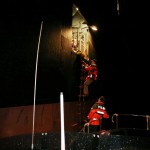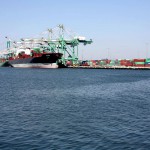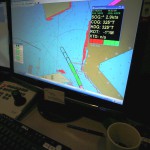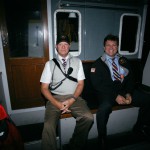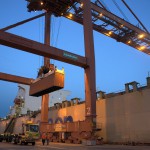It’s 3 a.m. on a Friday and the Port of Long Beach is blanketed in a heavy fog. Captain Robert Lukowski and his co-pilot Mark Coynes sit quietly on a small boat, heading out to meet the MSC Valeria, an enormous container ship the length of four football fields. Their job is to steer the Valeria safely into the Port of Long Beach, where its cargo will be unloaded.
Think of pilots Lukowski and Coynes as valet parking attendants, but on a much larger scale: Imagine trying to park the Empire State Building. At 366 meters long, the Valeria is so big that there’s only one parking spot in all of Long Beach port’s inner harbor large enough to accommodate it. Even still, it’s a very tight squeeze.
“A 2,000 container ship was a big ship when I started piloting,” recalls Capt. Lukowski. “Now those ships, they hardly exist.” The Valeria holds 7,000 containers, each one the size of what you might see on the back of a semi truck. It’s one of the biggest ships in the world.
If moving a ship was playing a piece of music, the pilot would be the conductor.
Captain Robert Lukowski
By moving more cargo in a single load, these big ships reduce the ratio of fuel needed per container. “The ships are so massive,” Lukowski says. “They’re carrying much, much more cargo, which is much more efficient.” In other words, big ships make economic sense.
Like everything at the ports, the ships reflect the economic climate. Before the 2008 financial crisis, the ports of Los Angeles and Long Beach experienced 20 years of what seemed like limitless growth. There was so much stuff to ship that the biggest worry at the ports was how to move as much cargo as possible through the harbor.
When the economy crashed in 2008, world trade came to a standstill, sending shockwaves through the entire shipping industry. Traffic coming through the Port of Los Angeles dropped 26 percent and about 20 percent in Long Beach. “Nobody was buying anything, nobody was shipping anything and so ships were laid up and not, you know, going anywhere,” says John McLaurin, who runs the Pacific Merchant Shipping Association.
In the two years that followed, fuel prices began to rise again and shipping companies started manufacturing bigger ships that could carry more cargo. The size of ships has increased more rapidly than anyone could have expected, almost doubling since 2008.

A look at how cargo ships have grown over time.
Ports across the world feel a need to become “big ship ready” in order to stay competitive. They are building the infrastructure to handle bigger ships by dredging the harbors to create a deeper channels, installing towering cranes to handle incoming cargo, and manufacturing automated vehicles that can efficiently move goods throughout the port.
Automation is coming to the ports of L.A. and Long Beach, too. At the Port of Los Angeles, a project is underway to build the first fully automated terminal on the West Coast. The renovations should be completed by 2016 and are being done for the shipping company TraPac Inc. At the Port of Long Beach, there’s a $1.5 billion project to develop Middle Harbor with bigger cranes and unmanned vehicles.
While automation will keep the ports of L.A. and Long Beach competitive economically, it also means fewer jobs. According to a report from the Los Angeles Harbor Department, automation could result in 160-200 fewer longshore jobs (longshoreman load and unload cargo from a docked ship). The actual number will depend on negotiations between the union and employers already underway.
- The small boat bringing Captains Lukowski and Coynes to the MSC Valeria must match the speed of the huge vessel so the pilots can climb safely aboard.
- While bigger ships mean saving money on fuel, they’re also forcing technological innovation at the ports.
- A view from the pilot station of the MSC Valeria, which is almost 400 meters long, squeezing into the harbor.
- Captains Lukowski and Coynes in a quiet moment while riding out to meet the MSC Valeria.
- Longshoremen load cargo from a rolling pallet onto a ship anchored by the dock at the Port of Los Angeles in 1939. Courtesy: WPA collection at the Los Angeles Public Library
- Today, ships are loaded and unloaded using enormous cranes that are operated by longshoremen. Plans are in place at both ports to install automated cranes and driverless trucks, which will mean even less workers at the terminal.


